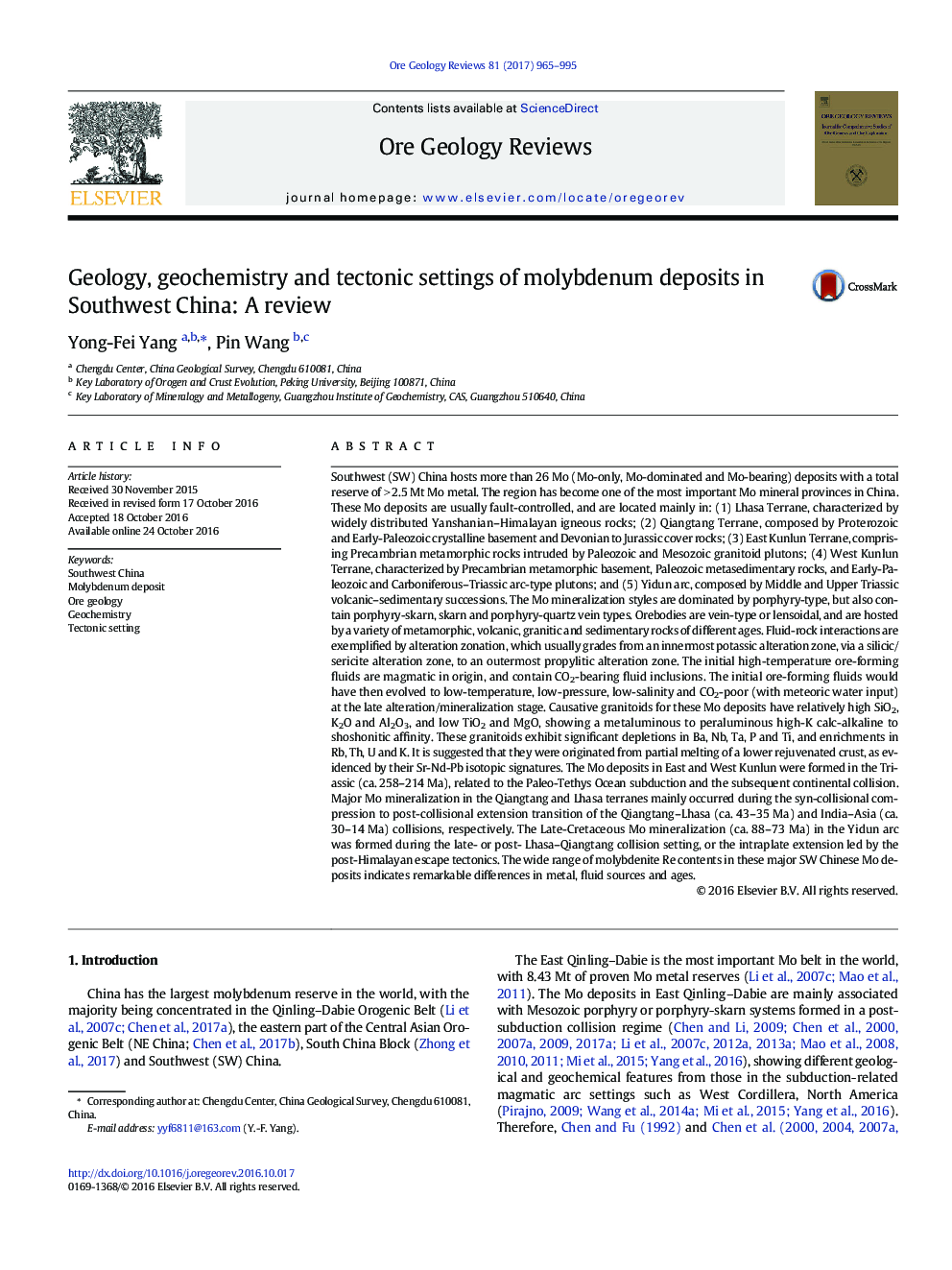| کد مقاله | کد نشریه | سال انتشار | مقاله انگلیسی | نسخه تمام متن |
|---|---|---|---|---|
| 5782579 | 1413926 | 2017 | 31 صفحه PDF | دانلود رایگان |
- Southwest China hosts more than 26 Mo deposits with total reserve of more than 2.5Â Mt Mo.
- Ore ages cluster mainly in 63-14Â Ma and 73-88Â Ma, minor in 258-214Â Ma.
- Ore types are porphyry, porphyry-skarn, skarn and porphyry-vein.
- Mo mineralization formed in various tectonic settings with various Re contents.
Southwest (SW) China hosts more than 26 Mo (Mo-only, Mo-dominated and Mo-bearing) deposits with a total reserve of >Â 2.5Â Mt Mo metal. The region has become one of the most important Mo mineral provinces in China. These Mo deposits are usually fault-controlled, and are located mainly in: (1) Lhasa Terrane, characterized by widely distributed Yanshanian-Himalayan igneous rocks; (2) Qiangtang Terrane, composed by Proterozoic and Early-Paleozoic crystalline basement and Devonian to Jurassic cover rocks; (3) East Kunlun Terrane, comprising Precambrian metamorphic rocks intruded by Paleozoic and Mesozoic granitoid plutons; (4) West Kunlun Terrane, characterized by Precambrian metamorphic basement, Paleozoic metasedimentary rocks, and Early-Paleozoic and Carboniferous-Triassic arc-type plutons; and (5) Yidun arc, composed by Middle and Upper Triassic volcanic-sedimentary successions. The Mo mineralization styles are dominated by porphyry-type, but also contain porphyry-skarn, skarn and porphyry-quartz vein types. Orebodies are vein-type or lensoidal, and are hosted by a variety of metamorphic, volcanic, granitic and sedimentary rocks of different ages. Fluid-rock interactions are exemplified by alteration zonation, which usually grades from an innermost potassic alteration zone, via a silicic/sericite alteration zone, to an outermost propylitic alteration zone. The initial high-temperature ore-forming fluids are magmatic in origin, and contain CO2-bearing fluid inclusions. The initial ore-forming fluids would have then evolved to low-temperature, low-pressure, low-salinity and CO2-poor (with meteoric water input) at the late alteration/mineralization stage. Causative granitoids for these Mo deposits have relatively high SiO2, K2O and Al2O3, and low TiO2 and MgO, showing a metaluminous to peraluminous high-K calc-alkaline to shoshonitic affinity. These granitoids exhibit significant depletions in Ba, Nb, Ta, P and Ti, and enrichments in Rb, Th, U and K. It is suggested that they were originated from partial melting of a lower rejuvenated crust, as evidenced by their Sr-Nd-Pb isotopic signatures. The Mo deposits in East and West Kunlun were formed in the Triassic (ca. 258-214Â Ma), related to the Paleo-Tethys Ocean subduction and the subsequent continental collision. Major Mo mineralization in the Qiangtang and Lhasa terranes mainly occurred during the syn-collisional compression to post-collisional extension transition of the Qiangtang-Lhasa (ca. 43-35Â Ma) and India-Asia (ca. 30-14Â Ma) collisions, respectively. The Late-Cretaceous Mo mineralization (ca. 88-73Â Ma) in the Yidun arc was formed during the late- or post- Lhasa-Qiangtang collision setting, or the intraplate extension led by the post-Himalayan escape tectonics. The wide range of molybdenite Re contents in these major SW Chinese Mo deposits indicates remarkable differences in metal, fluid sources and ages.
Journal: Ore Geology Reviews - Volume 81, Part 2, March 2017, Pages 965-995
